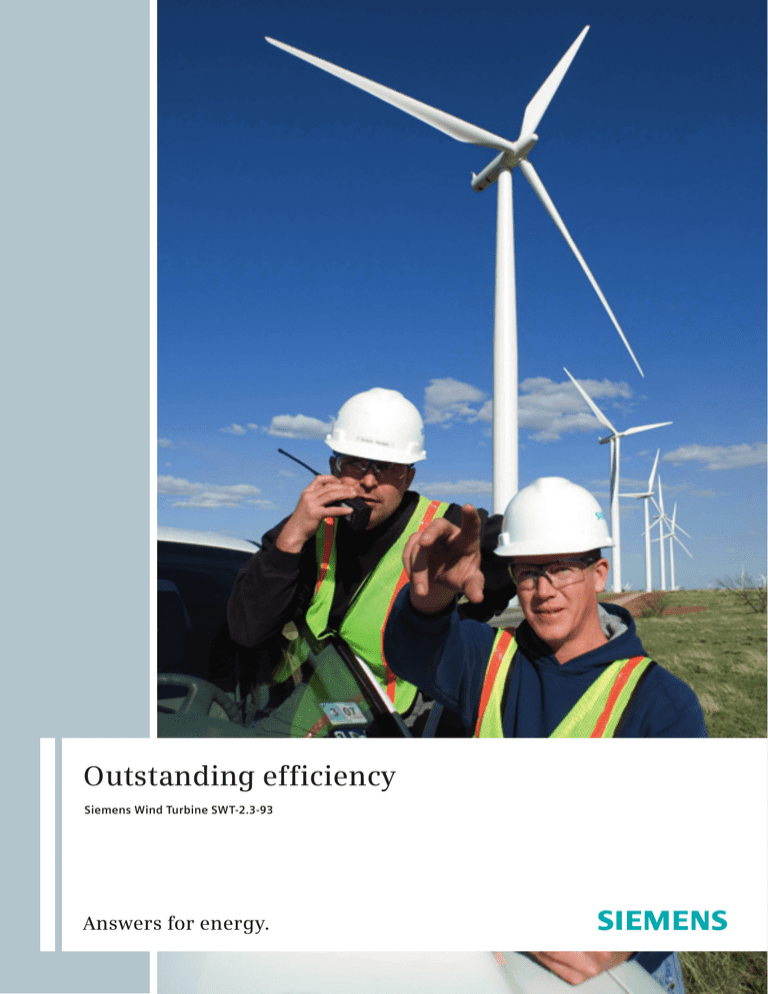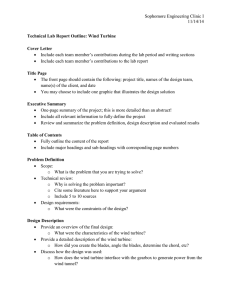
Outstanding efficiency
Siemens Wind Turbine SWT-2.3-93
Answers for energy.
2
Outstanding
efficiency
The SWT-2.3-93 wind turbine is the highestproductivity member of our 2.3 MW turbine
family.
Based on more than 25 years of leadingedge design and construction, it is
suitable for almost any type of
application, both onshore and offshore.
A rugged, conservative structural design,
automatic lubrication systems with
ample supplies, climate control of the
internal environment and a simple
generator system without slip rings
provide exceptional reliability at long
service intervals. Power conversion is
implemented with Siemens’ unique
NetConverter® system, offering
maximum flexibility in the turbine
response to voltage and frequency
control, fault ride-through and output
adjustment.
Major components, such as the rotor
hub, the main shaft, the gearbox and
the yaw system are all of particularly
heavy dimensions and all details are
designed using best engineering practice.
As a result, we offer the SWT-2.3-93
wind turbine – providing outstanding
efficiency and best-in-class technical
features.
3
Technical
description
General design
Rotor hub
The SWT-2.3-93 wind turbine is an upgraded version of the classical SWT-2.382 machine and includes the new B45
blade, a rotor diameter of 93 m, and
hence a 25 percent increase of the swept
area relative to the SWT-2.3-82 wind
turbine.
The rotor hub is cast in nodular cast
iron and is fitted to the main shaft with
a flange connection. The hub is large
enough to provide a comfortable working
environment inside the structure for two
service technicians during maintenance
of bolt connections and pitch bearings.
Rotor
Blade pitch system
The SWT-2.3-93 turbine has a threebladed rotor with pitch regulation for
power output optimization and control.
The rotor speed is variable in order to
maximize the aero-dynamic efficiency,
and speed compliance during power
regulation minimizes the dynamic loads
on the transmission system.
The blade pitch arrangement is used
to optimize and regulate power output
through the operating range. The blades
are feathered to minimize wind loads
during standstill under extreme wind
conditions.
Blades
The B45 blades are made of fiberglassreinforced epoxy in Siemens’ proprietary
IntegralBlade® manufacturing process.
In this process, the blades are cast in one
piece, leaving no weak points at glue
joints and providing optimum quality.
The aerodynamic design represents stateof-the-art wind turbine technology, and
the structural design has special Siemens
safety factors over and above all normal
industry and customer requirements.
4
Main shaft and bearing
The main shaft is forged in alloy steel
and is hollow for the transfer of power
and signals to the blade pitching system.
The main shaft is supported by a selfaligning double spherical roller bearing,
grease lubricated from an automatic
lubrication system. The bearing seals
are maintenance-free labyrinth seals.
Gearbox
The gearbox is a custom-built, threestage planetary-helical design. The
planetary-helical, high-torque stage
provides a compact high-performance
construction. The intermediary and highspeed stages are normal helical stages
arranged with an offset of the high-speed
shaft and thus allowing passage of power
and control signals to the pitch systems.
The gearbox is equipped with largecapacity cooling and filtering systems
that ensure optimum operating
conditions.
Generator
The generator is a fully-enclosed
asynchronous machine with squirrel-cage
rotor, which does not require slip rings.
The generator rotor construction and
stator windings are specially designed
for high efficiency at partial loads. The
generator is internally ventilated and
cooled with an air-to-air heat exchanger.
Mechanical brake
The mechanical brake represents the
secondary safety system of the turbine.
It is fitted to the gearbox high-speed
shaft and has two hydraulic calipers.
Yaw system
The yaw bearing is an externally geared
ring with a friction bearing. Eight electric
planetary gear motors drive the yawing.
The yaw gear motors are fitted with
brakes, assisting the passive friction of
the bearing for stable maintenance of the
yaw position.
Controller
A standard industrial computer is the
basis of the turbine controller. The
controller is self-diagnosing and includes
a keyboard and display for easy status
readout and adjustment of settings.
Power conversion
The NetConverter® power conversion
system allows generator operation at
variable speed, frequency and voltage
while supplying power at constant
frequency and voltage to the MV
transformer. The power conversion
system is a modular arrangement for
easy maintenance.
Tower
The SWT-2.3-93 turbine is mounted on a
tapered tubular steel tower. The tower
can be fitted with a personnel hoist as
an option.
Operation
Turbine Condition Monitoring
The wind turbine operates automatically,
self-starting when the wind reaches an
average speed of about 3–5 m/s. During
operation below rated power, the pitch
angle and rotor speed are continuously
adjusted to maximize the aerodynamic
efficiency. Rated power is reached
at a wind speed of about 13–14 m/s,
and at higher wind speeds the output
is regulated at rated power. Speed
compliance during power regulation
minimizes the dynamic loads on the
transmission system. If the average wind
speed exceeds the maximum operational
limit of 25 m/s, the turbine is shut down
by feathering of the blades. When the
wind drops back below the restart speed,
the safety systems reset automatically.
In addition to the WebWPS SCADA
system, the turbine is equipped with a
web-based Turbine Condition Monitoring
(TCM) system. The TCM system carries
out precise condition diagnostics on
main turbine components continuously
and in real time. It gives early warning
of possible component failures by
continuous comparison of current
vibration spectra with previously
established reference spectra. The TCM
system has various alarm levels, from
informative through alerting level to
turbine shutdown.
Remote control
The SWT-2.3-93 turbine is equipped
with the unique WebWPS SCADA system.
This system offers remote control and a
variety of status views and useful reports
from a standard Internet Web browser.
The status views present electrical and
mechanical data, operation and fault
status, meteorological data and grid
station data.
Grid compliance
The SWT-2.3-93 turbine complies with
all currently valid grid code requirements
on relevant markets. Voltage and
frequency control and other grid-related
adjustments can be implemented by
the integrated Park Pilot facility in the
WebWPS SCADA system, and the turbine
has ride-through capability for all
normal faults.
5
Technical
specifications
Rotor
Diameter
Swept area
Rotor speed
Power regulation
Generator
93 m
6,800 m2
6–16 rpm
Pitch regulation with variable speed
B45
45 m
Aerodynamic brake
Type
Activation
Full span pitch
Active, hydraulic
Transmission System
Gearbox type
Gearbox ratio
Gearbox oil filtering
Gearbox cooling
Oil volume
3-stage planetary/helical
1:91
Inline and offline
Separate oil cooler
Approx. 400 l
Mechanical brake
Type
Asynchronous
2,300 kW
690 V
Integrated heat exchanger
Yaw system
Blades
Type
Length
Type
Nominal power
Voltage
Cooling system
Type
Active
Monitoring system
SCADA system
Remote control
WebWPS
Full turbine control
Tower
Type
Hub height
Cylindrical and/or tapered tubular
80 m or site-specific
Operational data
Cut-in wind speed
Nominal power at
Cut-out wind speed
Maximum 3 s gust
Hydraulic disc brake
4 m/s
13–14 m/s
25 m/s
55 m/s (standard version)
59,5 m/s (IEC version)
Weights
Rotor
Nacelle
Tower
6
60 tons
82 tons
Site-specific
4
1
5
6
7
8
9
10
12
11
13
2
14 15
3
16 17
18
Sales power curve
Nacelle arrangement
The power curve data are valid for
standard conditions of 150 Celsius air
temperature, 1013 mBar air pressure
and 1.225 kg/m3 air density, clean rotor
blades, and horizontal, undisturbed
air flow.
1.
Spinner
10. Coupling
2.
Spinner bracket
11. Generator
3.
Blade
12. Service crane
4.
Pitch bearing
13. Meteorological sensors
5.
Rotor hub
14. Tower
6.
Main bearing
15. Yaw ring
7.
Main shaft
16. Yaw gear
8.
Gearbox
17. Nacelle bedplate
9.
Brake disc
18. Oil filter
19
20
19. Canopy
20. Generator fan
7
Published by and copyright © 2009:
Siemens AG
Energy Sector
Freyeslebenstrasse 1
91058 Erlangen, Germany
Siemens Wind Power A/S
Borupvej 16
7330 Brande, Denmark
www.siemens.com/wind
For more information, please contact
our Customer Support Center.
Phone: +49 180 524 70 00
Fax:
+49 180 524 24 71
(Charges depending on provider)
E-mail: support.energy@siemens.com
Renewable Energy Division
Order No. E50001-W310-A102-V6-4A00
Printed in Germany
Dispo 34804 c4bs No. 7491
fb 2091 WS 04095.
Printed on elementary chlorine-free
bleached paper.
All rights reserved.
Trademarks mentioned in this document
are the property of Siemens AG, its affiliates,
or their respective owners.
Subject to change without prior notice.
The information in this document contains
general descriptions of the technical options
available, which may not apply in all cases.
The required technical options should therefore
be specified in the contract.
www.siemens.com/energy





